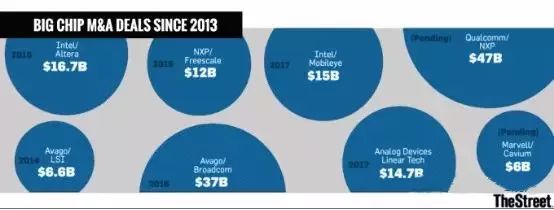Recently, chip makers have entered the tide of integration and mergers and acquisitions. Microchip's control component, Microchip (MCHP-US), announced on Thursday (1st) that it will acquire chip supplier Microsemi for $8.35 billion, or $68.78 per share.
In addition to the acquisition of Microsemi, Microchip recently acquired Atmel, analog equipment Analog Devices acquired Linear Tech, NXP NXP acquired Freescale, Infineon also acquired Rectifier. Qualcomm is also expected to include NXP in its $44 billion.
However, will the semiconductor consolidation continue?
TheStreet analyst Eric Jhonsa believes that Maxim, a $11.6 billion analogy provider, is expected to be recently acquired by Renesas of Japan, although Renesas strongly denies it. Although Maxim's corporate value (including debt) is 19 times that of free cash flow, there is still room for mergers and acquisitions to reduce costs and product line integration.
The Microcontroller Unit (MCU) is a microcomputer that contains memory, IO, and computing units for use in snap-in applications. It is smaller than the system on a chip (SOC).
In addition, Cypress (CY-US), a $5.8 billion MCU supplier in the industrial and automotive industries, has made it an important M&A target. Although its slower growth SRAM and NOR flash business groups are less pleasant, the chip product line that occupies WiFi Bluetooth and IoT applications is still quite attractive.
The report pointed out that the $4.1 billion IDT that supplies Samsung and other Android system OEM wireless charging components, and its broader product line is also one of the M&A targets. Semtech, a small and profitable supplier, is also a good M&A target for IoT, RF communications, and circuit protection.
Other well-known MCU vendors such as STMicro (STM-US) and Taiwan's Shengqun and Xintang.

Although semiconductor mergers and acquisitions have entered a period of easing in the past two years, from the beginning of this year's performance, semiconductor mergers and acquisitions have a new look. From the market point of view, the outstanding targets include the following companies:
The first is Silicon Labs; if you are concerned about the IoT market, you will find that Silicon Labs is a company with a rich IoT product line and relatively independent, which is very rare for the current semiconductor market.
IC Insights also believes that Silicon Labs is a very promising company. In the past 10 years, it has only a quarter of its losses (only $2 million in 1Q11), and its IoT product line is very broad. Among them are wireless Mesh solutions (such as Zigbee and Thread), as well as low-power 32-bit ARM microprocessors, sensors and other products.
In fact, Silicon Labs' M&A in the IoT market is also typical. In 2012, they acquired Ember and expanded the Zigbee product line. In 2013, they acquired Energy Micro, a company known for its energy-efficient MCUs. In 2015. They bought the wireless module supplier Bluegiga.
However, the strength of Silicon Labs is not in hardware, and its most lethal weapon is its own software development kit.
Like Broadcom's IoT team (which was acquired by Cypress last year), Silicon Labs also offers RAIL tools and a wireless networking software stack called Connect, which is specifically designed for private applications. The key to design.
But there is no doubt that Silicon Labs will not be very cheap.
Other potential acquisition targets include Skyworks, Macom and Qorvo, analysts said. As analog companies, their mobile products, such as RF and power management, are attractive sources, analysts added.
The analysts also pointed out that the above companies all have their own fabs, although future buyers can use these fabs to make and use it as an important part of the assets, but from today's market, these fabs are very May become a burden on the buyer.
In addition, sensor supplier InvenSense, analog mixed-signal supplier MaxLinear, and power tube psychochip maker PI are potential acquisition targets.
All of these companies are able to offer portable embedded devices with superior products, while also providing the wireless connectivity products needed in the IoT and central systems, plus IoT, cloud computing, automotive electronics and energy management. And other related products, which makes them the darling of the market.
If you are tired of the original back of your phone, you should try our 3D Relief Back Sticker. The Back Skin Protective Film on the back can not only bring you a visual change, but also protect the back cover of the phone itself from scratches and collisions. Real 3D touch, personalized and stylish pattern design. Bring you a perfect experience.
In daily use, it can protect the equipment from scratches, dust, impact and other damage.
Long-lasting anti-scratch effect, significantly reducing dust, oil stains and fingerprint stains.
Easy to install, easy to stick to the back of the phone, and will not damage the original appearance of the phone.
With the Protective Film Cutting Machine, you can install the Back Film on different types of mobile phone back shells, including mobile phones, tablet computers and other electronic products. Customization can be completed in 30 seconds with just one click.
If you want to know more about 3D Relief Back Sticker, please click product details to view the parameters, models, pictures, prices and other information about 3D Relief Back Sticker.
Whether you are a group or an individual, we will try our best to provide you with accurate and comprehensive information about 3D Relief Back Sticker!
3D Phone Sticker, Carbon Fiber Back Sticker, 3D Relief Back Sticker, 3D Printing Back Sticker, Phone Skin,Mobile Phone Back Sticker
Shenzhen Jianjiantong Technology Co., Ltd. , https://www.tpuscreenprotector.com